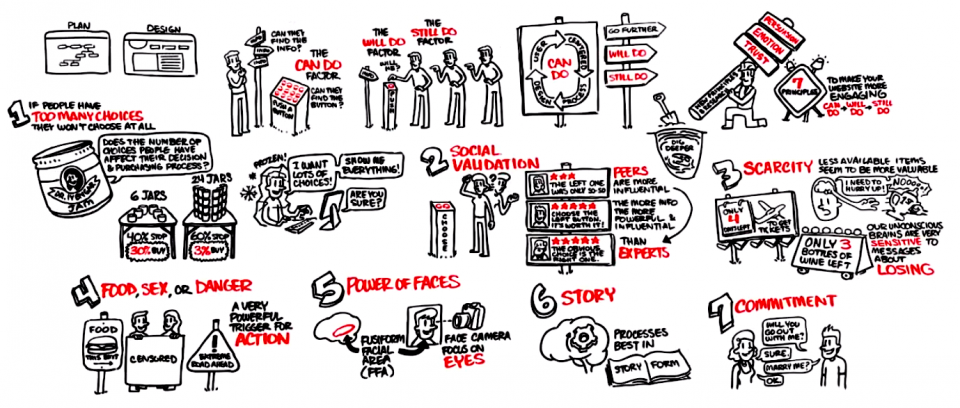7 principles that make your website more engaging..
"If you plan or design websites, then you know how important it is, that the website be easy to use.
Can they find the information they're looking for? Can they find the button they need to press? We call this the 'Can do' factor but 'Can do' is not all there is...
What about 'Will do'? They can find the button but will they press it? The can find the information but will they act on it? And then there is 'Still do'... will they come back? Will they be loyal?
If you follow a 'User Centered Design Process', you'll design a website that answers the 'Can Do' question but if you want to go further and answer the 'Will Do', and the 'Still Do' questions, you'll have to dig a little deeper and apply some of the new principles and research around persuasion, emotion and trust.
I'm going to share with you 7 principles that will make your websites more engaging, that will take you from can do to will do and still do.
#1. If people have too many choices, they won't choose at all.
One of my favourite studies in this area is Sheena Iyengar and Dr. Iyengar set up tables in grocery stores with jars of Jam and some of the tables have 6 jars of jam on them and sometimes the tables would have 24 jars of Jam & she was interested in finding out if the number of choices people had, affected their decision and purchasing process.
What she found was that the tables that had 6 jars of jam on them; 40% of the people coming by would stop and try the jam. On the tables that had 24 jars of jam on them, more people would stop; 60%, instead of 40% would stop and taste the jam. BUT there's a surprise when you look at how many people actually purchased.
When the tables had 6 jars of jam, 30% of the people actually purchased a jar of jam. When the tables had 24 jars of jam, even though more people stopped, only 3% of those who stopped, actually purchased and what we know is that people will tell us they want lots of choices and if you ask people "how many choices do you want at the website?"; they'll tell you "oh, show me everything"... but we now know that, they may want a lot of choices but if you give them too many choices, they'll freeze and not make a decision at all!
Principle 2 is that of social validation. What we know is that when people are uncertain, they'll look to others to decide what to do. this is why ratings and reviews and testimonials at websites are so powerful, especially if people are unsure and the more information that you can have in the rating and reviews, the more powerful & influential the rating and review is.
Research even shows that ratings and reviews from other people that 'I consider my peers', are the most influential! They're more influential than reviews or testimonials from experts or recommendations from the website itself.
Our 3rd principle is the principle of scarcity. So if something is unavailable or not very available; if its scarce, it seemed to be more valuable. So at a website where it says "Only 4 more days to order your plane ticket" or "Only 3 items left", those are signals to our brain that we'd better hurry up because we're going to miss out... and actually, our unconscious brains are very sensitive to messages that have to do with losing. fear of loss is a trigger that will cause us to take action.
#4. Our unconscious minds are very sensitive to food, sex or danger. Those will definitely get our attention. It's not always appropriate to use images of food, sex or danger at a website so you might not be able to make use of that but if the website that you're working on does lend itself to any of those images, that would be a very powerful trigger for action.
#5. The 'Power of faces'.
Theres actually a special part of the brain called the 'fusiform facial area' and this a part of the brain that only processes human faces and our brains are predisposed to pay attention to faces. If you have pictures of people at your website, you want to make sure they're looking right at the camera because research shows that people focus on the eyes.
#6. 'STORIES'.
Theres research that shows that the brain processes information best in story form.
And #7 is 'COMMITMENT'.
Start by asking people for very small commitments. Those small commitments can grow over time and then they become more and more loyal to your site...
And that makes 7. If you'd like to download and print a copy of this drawing, please go to www.humanfactors.com/PETposters.asp

